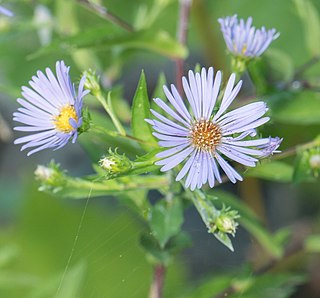
Symphyotrichum puniceum, is a species of flowering plant in the family Asteraceae native to eastern North America. It is commonly known as purplestem aster, red-stalk aster, red-stemmed aster, red-stem aster, and swamp aster. It also has been called early purple aster, cocash, swanweed, and meadow scabish.

Symphyotrichum laeve is a flowering plant native to Canada, the United States, and Coahuila (Mexico). It has the common names of smooth blue aster, smooth aster, smooth-leaved aster, glaucous Michaelmas-daisy and glaucous aster.
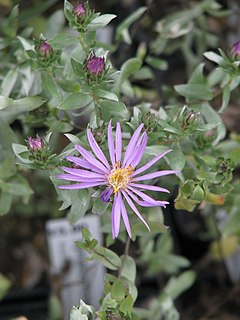
Symphyotrichum sericeum is a species of flowering plant in the family Asteraceae native to central North America. Commonly known as western silver aster, western silvery aster, and silky aster, it is a perennial, herbaceous plant that may reach 70 centimeters tall. Its flowers have purple ray florets and pink then purple disk florets, and its leaves are firm and silvery-green.

Symphyotrichum defoliatum is a species of flowering plant in the family Asteraceae known by the common name San Bernardino aster. It is endemic to Southern California where it grows in grasslands and meadows, and it is of conservation concern.

Symphyotrichum eatonii is a species of aster known by the common name Eaton's aster. It is native to much of western North America from British Columbia to Saskatchewan, the Sierra Nevada in California, the Rocky Mountains region, to Arizona and New Mexico, where it grows in many habitats, especially wet areas such as meadows and near ditches.

Symphyotrichum frondosum is a species of flowering plant in the family Asteraceae native to western North America. Commonly known as short-rayed alkali aster, it is an annual or perennial herbaceous plant that may reach 140 centimeters tall.

Symphyotrichum lentum is a species of flowering plant in the family Asteraceae with the common name of Suisun Marsh aster. It is a perennial and herbaceous plant endemic to the marshes of Sacramento-San Joaquin River Delta of Northern California.

Symphyotrichum georgianum is a rare species of flowering plant in the Asteraceae, the aster family. Its common name is Georgia aster. It is native to the southeastern United States where it is known from Alabama, Florida, Georgia, North Carolina, and South Carolina. As of 2013, it may be extirpated from the state of Florida.

Symphyotrichum patens, commonly known as late purple aster or spreading aster, is a perennial, herbaceous plant found in the eastern United States.

Symphyotrichum ciliolatum, commonly known as Lindley's aster and fringed blue aster, is a perennial herb native to Canada and the northern United States. It is also known as ciliolate wood aster and northern heart-leaved aster. The common name Lindley's aster honours John Lindley who first described the species in 1834.

Symphyotrichum robynsianum is a species of flowering plant in the family Asteraceae native to northeastern North America. Common names include Robyn's aster and long-leaved aster.
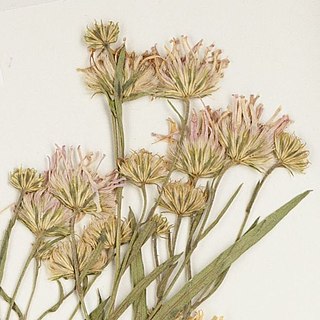
Symphyotrichum anticostense is a species of flowering plant in the family Asteraceae endemic to Quebec, New Brunswick, and Maine. Commonly known as Anticosti aster, it is a perennial, herbaceous plant that may reach 10 to 90 centimetres tall. Its flowers have pale purple or lilac, sometimes white, ray florets and yellow, then reddish purple, disk florets.

Symphyotrichum porteri is a species of flowering plant in the family Asteraceae endemic to the foothills of the Rocky Mountains in the U.S. states of Wyoming, Colorado, and New Mexico. Commonly known as Porter's aster, it is a perennial, herbaceous plant that may reach 10 to 50 centimeters tall. Its flowers have white, rarely pinkish, ray florets and yellow, becoming pink then brown, disk florets. S. porteri grows at elevations of 1,800–2,900 meters. Its limited range makes it a NatureServe Vulnerable (G3) species, and it is classified Critically Imperiled (S1) in Wyoming.
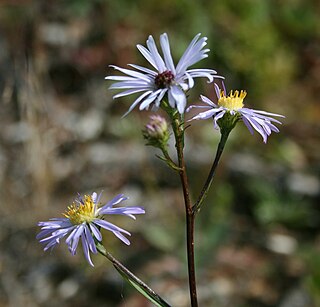
Symphyotrichum foliaceum is a species of flowering plant in the family Asteraceae native to western North America. Commonly known as leafy aster, leafy-bracted aster, and alpine leafybract aster, it is a perennial, herbaceous plant that may reach 10 to 60 centimeters in height. Its flowers have violet to purple ray florets and yellow disk florets. Four varieties were accepted as of July 2021 by Plants of the World Online (POWO), as follows: S. foliaceum var. apricum, S. foliaceum var. canbyi, S. foliaceum var. cusickii, and S. foliaceum var. parryi. The autonym is S. foliaceum var. foliaceum.
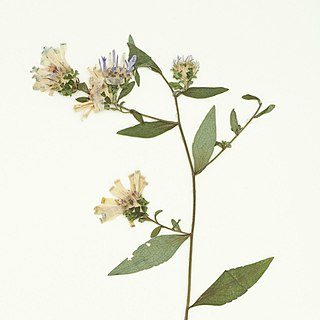
Symphyotrichum retroflexum is a species of flowering plant in the family Asteraceae native to the southeastern United States. Commonly known as rigid whitetop aster, it is a perennial, herbaceous plant that may reach 40 to 100 centimeters tall. Its flowers have blue to purple ray florets and cream to pale yellow then pinkish disk florets. It is known only from the Blue Ridge Mountains in Alabama, Georgia, North Carolina, South Carolina, Tennessee, and Virginia, where it grows in wooded areas at elevations of 400–1,500 meters. As of September 2021, NatureServe classified it as Apparently Secure (G4); however, it had been reviewed last in 1994 and is marked as "needs review." There is an introduced presence of S. retroflexum in southeast China.

Symphyotrichum pratense is a species of flowering plant in the family Asteraceae native to the southeastern United States. Commonly known as barrens silky aster, it is a perennial, herbaceous plant that may reach 40 to 60 centimeters tall. Its flowers have rose-purple ray florets and pink then purple disk florets.

Symphyotrichum fendleri is a species of flowering plant in the family Asteraceae native to the mid- and south-central United States, including Great Plains states and extending into Texas and New Mexico. Commonly known as Fendler's aster, it is a perennial, herbaceous plant that may reach 6 to 30 centimeters tall. Its flowers have lavender to purple ray florets and yellow then reddish purple disk florets.

Symphyotrichum undulatum is a species of flowering plant in the family Asteraceae native to eastern North America. Commonly known as wavyleaf aster, it is a perennial, herbaceous plant that may reach 30 to 60 centimeters tall. Its flowers have blue to purple, or sometimes lilac, ray florets and cream or light yellow, then purple, disk florets.

Symphyotrichum eulae is a species of flowering plant in the family Asteraceae endemic to Texas. Commonly known as Eula's aster, it is a perennial, herbaceous plant that may reach 5 to 150 centimeters tall. Its flowers have white to lavender-pink ray florets and yellow then red to brown disk florets. It was named for Eula Whitehouse, American botanist, botanical illustrator, and plant collector.

Symphyotrichum chapmanii is a species of flowering plant in the family Asteraceae native to the Apalachicola River drainage basin of Alabama and Florida. Commonly known as savanna aster, it is a perennial, herbaceous plant that may reach 30 to 80 centimeters tall. Its flowers have purple to blue-lavender ray florets and pale yellow disk florets. It is a wetland species and is of conservation concern. It may be extirpated in Alabama.






















